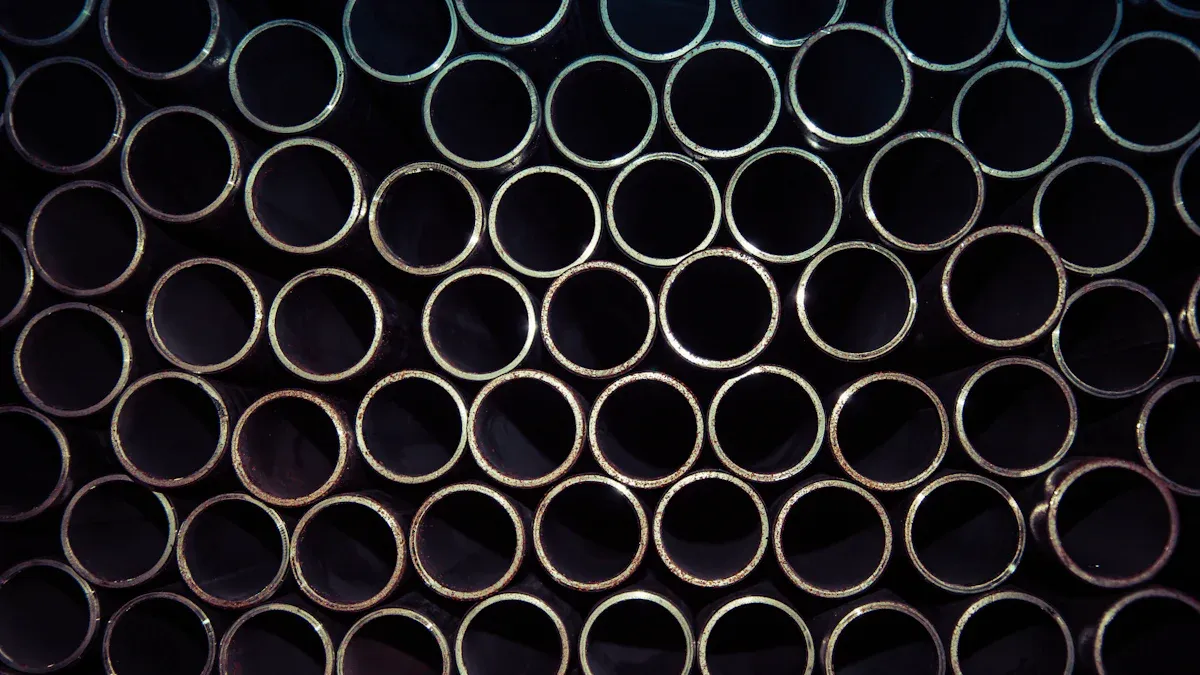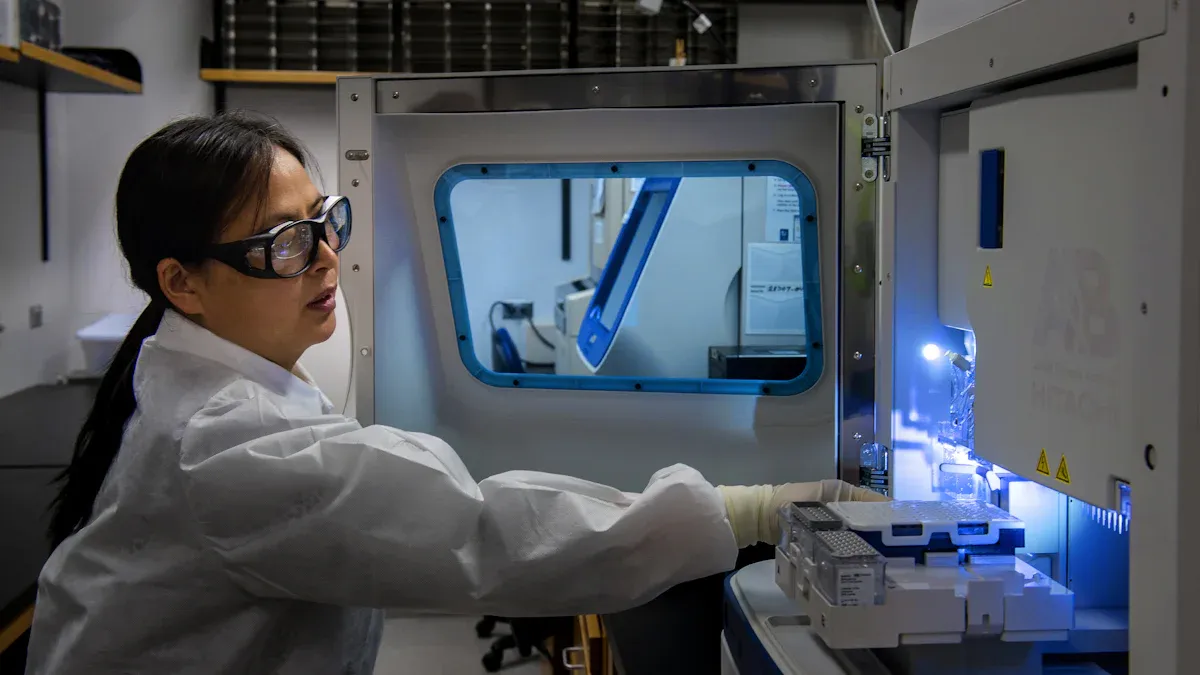The Science Behind Nitinol's Shape Memory and Superelasticity

Imagine a material that can "remember" its original shape even after being bent or twisted. This is the magic of Nitinol, a remarkable alloy of nickel and titanium. Its unique properties allow it to return to its original form through thermal activation or stress release. For example, Nitinol's Young's modulus ranges from 20–50 GPa in its martensitic phase to 40–90 GPa in its austenitic phase, showcasing its adaptability. These shape memory properties and superelastic behavior make Nitinol tubing indispensable in industries like medicine and robotics. But what gives Nitinol these extraordinary abilities?
Key Takeaways
Nitinol is a special metal made of nickel and titanium. It can return to its original shape after being bent or stretched.
Temperature affects how Nitinol works. It changes between soft and hard forms depending on the heat, making it useful for many purposes.
Nitinol is safe for the body and does not rust. This makes it great for medical tools like stents and wires, helping patients feel safer and more comfortable.
Nitinol is strong and lasts a long time. It can be used again and again without breaking, which is perfect for robots and airplanes.
The Science Behind Shape Memory Alloys
Nitinol's Composition and Atomic Structure
Nickel and titanium: The foundation of Nitinol
Nitinol, a nickel titanium alloy, owes its remarkable properties to its unique composition. It consists of approximately 50 to 51% nickel by atomic percent and 49 to 50% titanium. This precise balance is essential for its shape memory function and superelastic properties. The combination of these two elements creates a material with extraordinary flexibility and durability.
The nickel provides strength and corrosion resistance, while titanium contributes to its lightweight nature and biocompatibility. Together, they form the foundation of Nitinol's ability to "remember" its original shape and return to it after deformation.
How atomic structure enables shape memory properties
The atomic structure of Nitinol plays a crucial role in its shape memory effect. In its high-temperature austenitic phase, the atoms are arranged in a compact, crystalline structure. This ordered arrangement gives the material its rigidity and stability. When cooled, Nitinol transitions to the martensitic phase, where the atoms rearrange into a more flexible, twinned structure. This phase allows significant deformation without permanent damage.
This phase transformation is reversible, enabling Nitinol to recover its original shape when heated. The ability to switch between these phases underpins its shape memory properties and makes it a standout among shape memory alloys.
Phase Transformation in Nitinol
Austenitic phase: High-temperature stability
In the austenitic phase, Nitinol exhibits high-temperature stability. The atoms align in a rigid, crystalline structure, which allows the material to maintain its original shape under stress. This phase is responsible for the superelastic properties of Nitinol, enabling it to withstand significant deformation and return to its initial form.
Martensitic phase: Low-temperature flexibility
At lower temperatures, Nitinol enters the martensitic phase. In this state, the atomic structure becomes more flexible, adopting a twinned configuration. This flexibility allows the material to bend and stretch without breaking. The martensitic phase is key to Nitinol's shape memory function, as it can deform and then revert to its original shape upon heating.
The role of temperature in phase transformation
Temperature regulation is critical in controlling Nitinol's phase transformation. For example, experiments show that at 18°C, Nitinol remains in the martensitic phase, allowing it to stretch and deform. At 81°C, it transitions to the austenitic phase, regaining its original shape. This temperature-dependent behavior highlights the importance of precise temperature control in applications of Nitinol shape memory alloy.
Temperature (°C) | Phase | Behavior Description |
|---|---|---|
18 | Martensite | Spring stretched due to detwinning and elastic deformation. |
81 | Austenite | Spring exhibited elastic, almost linear behavior. |
Variable | Martensite | Different responses under similar loading conditions depending on the history. |
Mechanisms of Shape Memory Function and Superelasticity
Thermal activation and shape recovery
Thermal activation is the driving force behind Nitinol's shape memory effect. When you heat Nitinol above its transformation temperature, it shifts from the martensitic phase to the austenitic phase. This transition allows the material to recover its original shape, even after significant deformation. The transformation temperatures can range from −20°C to +110°C, depending on the specific alloy composition.
Stress-induced phase transformation
Stress-induced phase transformation is another mechanism that enables Nitinol's superelastic properties. When you apply stress to Nitinol in its austenitic phase, it temporarily transitions to the martensitic phase. This change allows the material to absorb energy and deform without permanent damage. Once the stress is removed, Nitinol reverts to its austenitic phase, regaining its original shape. This unique behavior makes Nitinol ideal for applications requiring flexibility and durability.
Material Properties of Nitinol

Thermal Properties
Transformation temperatures and their role
The transformation temperatures of nitinol play a crucial role in its functionality. These temperatures dictate when the material transitions between its martensitic and austenitic phases, enabling its unique shape memory properties. For example, the Austenite Finish (AF) temperature determines when nitinol fully returns to its original shape after deformation. This makes it essential for applications requiring precise movement and reliability.
The composition of nitinol, particularly the nickel-to-titanium ratio, directly impacts these transformation temperatures. By adjusting this ratio, you can customize nitinol for specific uses, such as medical devices or aerospace components. This adaptability highlights why nitinol stands out among shape memory alloys.
Heat's impact on shape memory function
Heat activates nitinol's shape memory effect. When heated above its transformation temperature, nitinol shifts from the flexible martensitic phase to the rigid austenitic phase. This change allows it to recover its original shape, even after significant deformation. This property is why nitinol is used in applications like stents and orthodontic wires, where precise shape recovery is critical.
Mechanical Properties
Superelasticity and deformation limits
Superelastic nitinol exhibits remarkable deformation limits. It can stretch significantly and still return to its original shape without permanent damage. For instance, mechanical testing shows that nitinol can handle mean strains of up to 4% and transformation strains of around -4.1%. This makes it ideal for applications requiring flexibility and durability, such as medical implants and actuators.
Mean Strain | Alternating Strain Limit |
|---|---|
2.0% - 2.5% | 1.5% - 0.8% |
3.5% - 4% | N/A |
Durability and fatigue resistance
Nitinol's durability and fatigue resistance set it apart from conventional materials. It can endure repeated cycles of deformation without losing its shape memory properties. For example, process-optimized nitinol tubing can handle maximum local strains of up to 6%, ensuring long-term reliability. This durability makes nitinol a preferred choice for demanding applications like aerospace and robotics.
Specimen Type | Fatigue Safety Limit | Maximum Local Strain |
|---|---|---|
Sputtered Nitinol | 1.75% | >4% |
Process-optimized Tube | N/A | 6% |
Biocompatibility and Corrosion Resistance
Why Nitinol tubing is ideal for medical applications
Nitinol's biocompatibility and corrosion resistance make it ideal for medical applications. It is non-toxic and well-tolerated by the human body, reducing the risk of rejection or infection. These properties are crucial for long-term implants like stents and surgical tools. Nitinol-based orthopedic implants also provide stability and improved patient comfort, enhancing outcomes in medical procedures.
Resistance to environmental factors
Nitinol resists corrosion, even in harsh environments. This prevents rusting and degradation, ensuring a prolonged lifespan for devices made from this material. Whether used in medical, aerospace, or consumer applications, nitinol's resistance to environmental factors ensures consistent performance and reliability.
Nitinol's combination of shape memory properties, superelasticity, and durability positions it as a revolutionary material across industries.
Applications of Nitinol in Modern Industries

Biomedical Applications
Stents, guidewires, and orthodontic devices
Nitinol has revolutionized biomedical engineering by enabling the creation of innovative medical devices like stents, guidewires, and orthodontic tools. For example, self-expanding stents made from nitinol tubing can be inserted into arteries in a collapsed state. Once inside the body, the stent expands to its original shape at body temperature, improving blood flow and supporting the artery. This adaptability makes nitinol indispensable in minimally invasive procedures. Its biocompatibility ensures safety and reduces the risk of complications, making it a preferred material in healthcare.
Enhancing patient outcomes with Nitinol tubing
Nitinol tubing plays a critical role in enhancing patient outcomes. Its shape memory and superelasticity allow medical devices to adapt to the body’s natural movements, improving comfort and effectiveness. For instance, nitinol-based guidewires navigate complex vascular pathways with ease, reducing procedure times. Orthodontic devices made from nitinol tubing apply consistent pressure, leading to faster and more comfortable teeth alignment. These advancements highlight nitinol’s transformative impact on patient care.
Aerospace and Automotive Applications
Actuators and sensors in advanced systems
In aerospace and automotive industries, nitinol is used to create actuators and sensors that perform reliably under extreme conditions. Miniature actuators made from nitinol tubing offer precise control and durability, making them ideal for advanced systems. For example, nitinol’s shape memory properties allow actuators to respond to temperature changes, enabling efficient operation in aircraft and vehicles. This adaptability supports the growing demand for performance optimization in these industries.
Lightweight, durable components
Nitinol’s lightweight yet durable nature makes it a valuable material for aerospace and automotive components. Its high strength-to-weight ratio improves fuel efficiency in aircraft and enhances vehicle performance. Additionally, nitinol’s resistance to corrosion and fatigue ensures long-term reliability, even in challenging environments. These properties make it a key material for modern transportation technologies.
Consumer Electronics and Emerging Uses
Flexible eyeglass frames and mobile devices
Nitinol’s flexibility and resilience have found applications in compact consumer electronics. Flexible eyeglass frames made from nitinol tubing can withstand bending and twisting without breaking, offering durability and comfort. In mobile devices, nitinol’s unique properties enable the development of flexible displays and resilient connectors, paving the way for next-generation electronics.
Innovations in wearable technology
Wearable technology has embraced nitinol for its ability to combine durability with adaptability. Miniature actuators made from nitinol tubing are being integrated into smartwatches and fitness trackers, enhancing functionality. These applications demonstrate nitinol’s potential to drive innovation in compact consumer electronics and wearable devices.
Market Insight:
The global demand for nitinol and other shape memory alloys is projected to reach $7 billion by 2025, with a compound annual growth rate of 5.3%. This growth reflects the increasing adoption of nitinol across industries, from biomedical engineering to consumer electronics.
Industry | Application Description |
|---|---|
Healthcare | Nitinol is used in medical devices like stents and guidewires, driven by the need for improved performance and safety. |
Automotive | Enhances vehicle components' performance and efficiency, supporting the trend towards electric and hybrid vehicles. |
Aerospace | Improves aircraft components' performance and reliability under extreme conditions. |
Consumer Electronics | Utilized in next-generation electronic components, such as flexible displays and resilient connectors. |
Robotics | Explored for innovative solutions in robotic applications. |
Construction | Investigated for potential applications in construction materials. |
Energy | Being researched for use in energy-related technologies. |
Nitinol’s versatility continues to expand its applications across industries, making it a cornerstone of modern innovation.
Advancements and Future Prospects for Shape Memory Alloys
Innovations in Nitinol Manufacturing
Controlling transformation temperatures
You might wonder how manufacturers fine-tune nitinol's behavior for specific applications. The answer lies in precise temperature control during production. By adjusting the nickel-to-titanium ratio and applying heat treatments, manufacturers can set the transformation temperatures that dictate when nitinol shifts between its martensitic and austenitic phases. This customization ensures nitinol performs optimally in diverse environments, from medical devices to aerospace components.
Advances in 3D printing with Nitinol
3D printing has revolutionized the manufacturing of nitinol. This technology allows you to create intricate designs that were previously impossible with traditional methods. For example, nitinol's unique properties make it ideal for producing minimally invasive medical devices like arterial stents. However, retaining nitinol's mechanical properties during additive manufacturing remains a challenge. Advances in materials science are addressing these issues, paving the way for high-quality, 3D-printed nitinol components.
Benefits of 3D printing with nitinol:
Enables complex geometries for medical and industrial applications.
Reduces material waste compared to traditional manufacturing.
Accelerates prototyping and production timelines.
Advancement Type | Description |
|---|---|
Shape Setting | Heat treatment and specialized fixtures allow nitinol to form intricate shapes that "remember" their original form. |
Superelastic Processing | Specific heat treatments enhance nitinol's ability to absorb energy and return to its original shape. |
Research and Development | Continuous efforts improve nitinol's properties and expand its applications. |
Expanding Applications of Nitinol
Robotics and artificial intelligence
Nitinol is transforming robotics and artificial intelligence. Its shape memory and superelastic properties enable the creation of flexible, lightweight components for robotic systems. For instance, nitinol actuators mimic human muscle movements, enhancing the precision and adaptability of robots. As AI continues to evolve, nitinol's role in robotics will only grow, offering new possibilities for automation and innovation.
New frontiers in medical technology
In medical technology, nitinol is breaking new ground. Its corrosion resistance and biocompatibility make it a top choice for implants and surgical tools. Nitinol stents, for example, outperform traditional stents by adapting to the body's natural movements. The integration of AI into medical devices further enhances their accuracy and efficiency, improving patient outcomes. With a projected market growth rate of 10.4% through 2028, nitinol's impact on healthcare is set to expand significantly.
Parameter | Description |
|---|---|
Market Dynamics | Insights into market drivers and restraints affecting nitinol applications in robotics and medical tech. |
Technological Advancements | Highlights the role of new technologies in enhancing nitinol applications. |
Statistical Forecasts | Projections indicate a compound annual growth rate of 10.4% through 2028. |
Challenges and Opportunities
Addressing cost and scalability
Despite its advantages, nitinol faces challenges in cost and scalability. High raw material costs and complex manufacturing processes make it more expensive than other materials. Fluctuating titanium prices and stringent FDA regulations add to these difficulties. However, advancements in manufacturing techniques, such as the shape setting process, aim to reduce costs and improve scalability. Emerging markets like China and India, with growing healthcare infrastructure, also present significant opportunities for nitinol's expansion.
Research into alternative shape memory alloys
While nitinol dominates the market, researchers are exploring alternative shape memory alloys to address its limitations. These alternatives aim to offer similar properties at a lower cost or with enhanced performance. For example, alloys with improved corrosion resistance or higher transformation temperatures could expand the range of applications for shape memory materials. This ongoing research ensures that the field of shape memory alloys continues to evolve, offering new solutions for modern challenges.
Tip: The demand for nitinol in minimally invasive procedures and robotics is driving innovation in manufacturing and application development. Staying informed about these advancements can help you understand the future potential of shape memory alloys.
Nitinol’s shape memory and superelastic properties make it a game-changer across industries. You see its impact in healthcare, where minimally invasive devices like stents and guidewires improve patient outcomes. Aerospace and robotics also benefit from its durability and adaptability.
Key Insights:
Companies like Abbott Laboratories and Medtronic are advancing Nitinol-based cardiovascular devices.
Emerging economies and new technologies drive growth in Nitinol applications.
Aspect | Description |
|---|---|
Strengths | Unique properties, biocompatibility, and wide-ranging applications. |
Future Opportunities | Expanding use in robotics, energy storage, and smart materials. |
AccuPath continues to innovate with Nitinol, unlocking its potential for a brighter, more efficient future.
FAQ
What makes Nitinol different from other materials?
Nitinol stands out because of its shape memory and superelasticity. It can return to its original shape after deformation. Its unique nickel-titanium composition allows it to switch between flexible and rigid phases, making it ideal for medical, aerospace, and consumer applications.
How does temperature affect Nitinol's behavior?
Temperature controls Nitinol's phase transformation. At lower temperatures, it becomes flexible (martensitic phase). When heated above its transformation temperature, it becomes rigid and regains its original shape (austenitic phase). This property is key to its shape memory function.
Is Nitinol safe for medical use?
Yes, Nitinol is biocompatible and corrosion-resistant. These properties make it safe for implants like stents and surgical tools. AccuPath ensures its Nitinol products meet strict medical standards, providing reliable and safe solutions for healthcare applications.
Can Nitinol handle repeated use?
Nitinol is highly durable and resists fatigue. It can endure repeated deformation cycles without losing its shape memory or superelastic properties. This makes it a reliable choice for long-term applications in robotics, aerospace, and medical devices.
How does AccuPath contribute to Nitinol innovation?
AccuPath focuses on advancing Nitinol manufacturing techniques. By refining transformation temperatures and exploring 3D printing, AccuPath creates high-quality, customizable Nitinol products. These innovations expand its applications across industries, from healthcare to consumer electronics.
See Also
Comprehensive Overview of Nitinol Parts and Production Methods
Understanding Nickel Titanium's Role in Healthcare Innovations
Why NiTi Tubes Revolutionize Medical and Aerospace Industries
Improving Catheter and Implant Efficiency with Nickel-Titanium Tubing
Current Developments in Nickel Titanium Alloys and Their Applications

